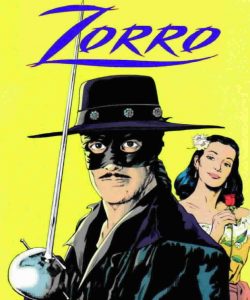A pencil moustache, the long cape, a black mask and hat. In the hundred years that his image has inspired movie goers, Zorro has changed very little. Along with that, the messages and themes have stayed consistent with each new Zorro film and TV show.
It all started in 1920 with the Douglas Fairbanks film The Mark of Zorro. Spanish for ‘fox,’ Zorro, the swashbuckling hero slies his way around his village making fools out of ill-willed noblemen and the unjust authority. Zorro’s objective is simple: do good for the people who need help. But what role does the Zorro’s other half Don Diego Vega play?
Vega stands in the middle of the moral spectrum. This contrast forces Zorro to fight not only Juan Ramon but also Don Diego. Vega’s personal agenda does not push for moral goodness. He is no romantic and not physically or emotionally driven. It is too simple to just assume that the nature of Vega’s character is a disguise so that the other characters do not believe that he is Zorro. Vega represents the contempt that everyone feels with themself. Zorro fights injustice, greed, and as the opening credits say, “Oppression.” But he also fights the people in society who take no action at all. Zorro’s character is much more appealing and exciting because he wants action and want to protect people. He even desires the girl. Behind all of this is the fact that Zorro wants what is morally right. Vega’s indolence is not just unappealing; it is morally wrong. In the end, what appears to be Vega the victor, is really Zorro without the cape.
While watching the film I struggled to place a date on when the story took place. The characters wore old clothes and lived in old homes. Even in 1920, Zorro was a ‘time period’ film. It took place one hundred years in the past. However, the time is not the focus of the film. And just like the irrelevance of the period when the film takes place, when it comes to the role of Mexico, New Spain, or Latin America, the physical setting of Zorro is secondary to the importance of its message. It is less about the ‘exoticism’ that America views toward Latin America. More important are social messages about equality and injustice, greed and oppression. The issues that Zorro faces are timeless social problems. 1920’s America saw a great divide in social and economic classes. Zorro was fighting these problems then, and he still is now.

Diego does mention in leaving the tavern before changing into Zorro that “it is good to root out evil in society,” I’m paraphrasing here, to the sergeant and his gang who will go to San Capistrano the very next day to deal with Zorro. I still see Diego as an information gatherer and provocateur, a role that Zorro depends on in order to do his swashbuckling.